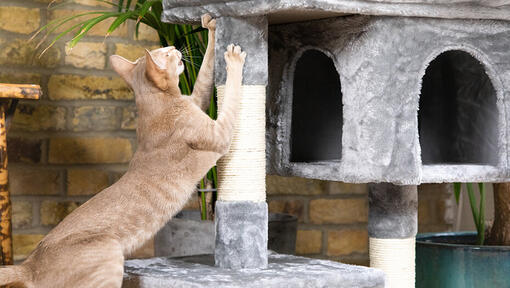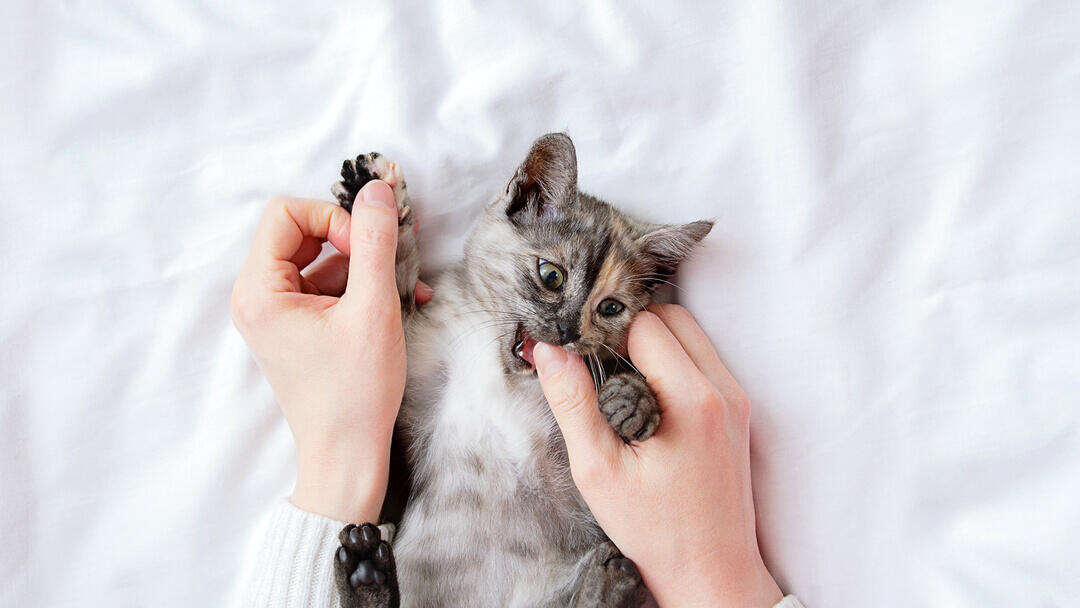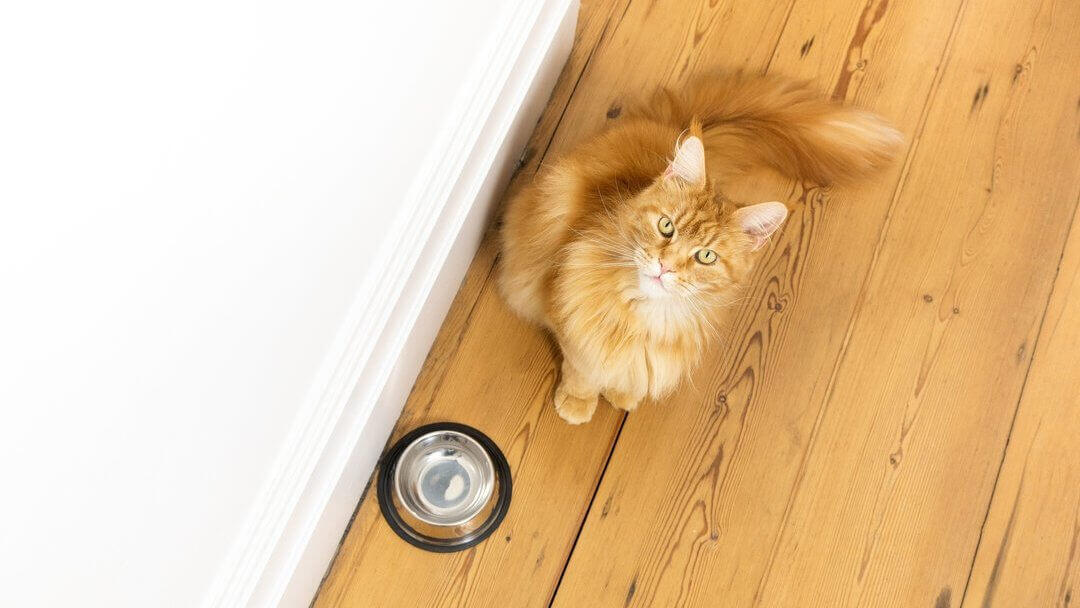


Whether we like it or not, due to their natural hardwired behaviours and instincts, cats often behave in ways that we would really rather they didn’t. It is important for owners to manage their cat’s environment to give them an appropriate outlet for these behaviours. It is not fair to punish a cat for behaving like a cat!
We do however need to know how to prevent those behaviours that are dangerous, painful or just inappropriate in the felines that share our lives and our homes. So read on…
Understanding Different Bad Cat Behaviours
It is important to remember that while we may not like these behaviours, they are natural for cats. They are undesirable for us – not for your cat. If your cat is doing any of these, they are not being ‘bad’ – they are just being cats!
Cat Scratching your home
Scratching items in your house, such as sofas and tables, is a very common behaviour as cats need to be able to sharpen their claws and keep them in good condition. They may also be doing this to mark territory especially in a multi-cat household.
This kind of behaviour can be costly, so it’s definitely something you need to manage in order to prevent them from wrecking your house.
This isn’t about disciplining your cat – it is about making sure they have plenty of appropriate opportunities to indulge in some claw care. Provide scratching posts in every room your cat spends time in – and find out what material your cat particularly enjoys scratching on and provide that for them.
Also look at their other enrichment opportunities to make sure they are not bored or frustrated.
Cat Biting
Biting is a behaviour that many cats tend to show, especially if they have not been socialised or appropriately handled as kittens. This kind of behaviour is particularly undesirable and can affect your relationship with your cat.
Humans and cats show affection very differently. We tend to like quite intense and prolonged physical contact (think hugs!). Cats usually enjoy very short periods of affection before it all gets a bit overwhelming, and they can respond by biting or scratching. Some cats crave your company but not your touch.
Make sure all interactions between you are your cat’s idea. If they solicit affection, give it to them – low key and in very short bouts (about 5 seconds). And then stop. If they move away, that’s fine but if they push against you and want you to continue, you have ‘permission’ to do so but only for another 5 seconds. By doing this, you are not going to overwhelm them with the intensity of your affection, and they can start to trust you not to overwhelm them. By doing this, they are far less likely to feel they need to get toothy and they will trust your hands a lot more!
Another reason that your cat may bite you is they think it’s just playing. Most cat play is based on practising their hunting behaviours – and this comes with teeth and claws! Like many animals, sometimes cats can play rough and do not intentionally mean to harm you. This doesn’t mean however that the bites don’t hurt, so this is something you want to discourage. Use toys when playing games with your cats (‘things on strings’) that they can grab, bite and shred to their heart’s content and keep your hands well out of the way.
The final reason a cat may bite you is that he is trying to communicate with you. If a cat gives you a small nip and then tries to lead you off in a direction it’s possibly a sign they want something and you’ve been ignoring their more subtle hints. This could be that they are hungry, they want a door to be opened or they are trying to show you something. It’s a good reminder to pay more attention to your cat’s body language!
Some cats can become predatory and start to stalk and hunt their owner. If this is happening with your cat, it is usually a sign of a lack of appropriate enrichment that has led to boredom and frustration – and it may be time to talk to a feline behaviourist. Here’s more information on how to stop your cat from biting.
Why Do Cats Bring You Dead Animals?
As a cat owner, the sight of a dead animal being brought into your home may be all-too familiar. Many cat owners come home to be greeted by a dead bird or small mammal on their living room floor. Cats are expert hunters and top of the tree predators, and this survival behaviour is sadly very natural – especially if they do not have an appropriate outlet for their natural hunting behaviours.
Even though we provide our cats with plenty of food, the instinct to stalk, chase, catch and kill is hardwired – and the relationship we have with our cats mean that they want to share their ‘prize’ with us.
Telling your cat off for this behaviour is counter-productive and will break down the relationship you have with your feline friend. Hunting, catching and killing is inherently rewarding for cats – it gives them the brain buzz of positive neurotransmitters that make them feel content and happy. To then be told off by you causes conflict. Far better you give them appropriate and rewarding outlets for this hunting behaviour with play, games, and enrichment – and for those expert hunters, consider restricting their outdoor space to a catio filled with enrichment opportunities.
Disciplining your cat
It is important to remember that all the behaviours that lead us to think we might want to discipline our cat are natural ones and first of all, we need to make sure we are giving them appropriate outlets for their hardwired behaviours that make a cat a cat!
The most effective way to encourage good behaviour so you don’t have to discipline your cat is to reward them when they have done well. This reward could be in the form of a small treat that they could eat or even just you showing them attention and affection. This positive reinforcement will encourage a cat to replicate good behaviours. This is especially effective when litter training kittens and cats.
Using a special, distinctive tone of voice can be an effective way to communicate with your cat when you don’t approve of their behaviour. Doing this whilst repeating a simple word like “no” can be helpful (although some cats will totally ignore you!). It’s important that you do not raise your voice and start shouting at your cat – and never use physical punishment as this will break down the bond between you as well as scaring your cat.
Another way to discipline your cat if they are doing wrong something you don’t want them to do is to remove them from the situation. This can be effective when cats are trying to take food or are climbing on worktops. If you choose to train your cat in this way, it is important that you repeat it every time they show that behaviour (such as jumping on the worktops. If you begin to slip and let them do it sometimes they will get confused as to why sometimes you react to certain behaviours and other times you don’t. It’s also important that everyone in the household does the same thing.
If after reading all of the above, and making sure your cat has appropriate enrichment and also an outlet for their hardwired behaviours, you are still worried about your cat’s behaviour, talk to a feline behaviourist who can help you restore harmony.
You could see a visible difference in just 3 weeks*
Keep your cat healthy by feeding her with PURINA ONE or get your money back.
*PURINA ONE 3 Weeks Challenge - Internal technical support dossier, R&D note written July 2016, revised 2021.

More articles by Purina One



